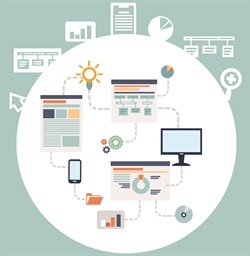Best Practices for Tracking & Reporting Customer Information
3 min read

These days, data is everywhere - and this is one trend that shows absolutely no signs of reversing itself anytime soon. According to one recent study, more data was created in the last two years alone than in the entirety of human history leading up to that point - combined. Likewise, by as soon as 2020, there will be roughly two megabytes of new data created for every single person on Earth once every second.
But at the same time, all of this poses a pretty important question - in an era where the world is currently watching Facebook testify in front of Congress about consumer data privacy (or a decided lack thereof), how exactly are you supposed to actually manage all of this data in a safe and effective way? How do you unlock the benefits of having so much data like taking a more proactive approach to servicing your audience while heading off as many of the downsides as possible? That, of course, requires you to keep a few key things in mind.
The Best Practices for Managing Customer Information: What You Need to Know
Your business systems and processes should absolutely be built in a way that maximizes both employee efficiency and profitability - obviously, the same is absolutely true of your customer information tracking and reporting infrastructure, too. Before you do anything, you need to relieve yourself of the notion that you can handle a task as important as this one with off-the-shelf software. You simply can't, end of story.
All of this leads to the same destination: some type of custom reporting solution that was built with your unique organization in mind. Any such solution that you invest in will need to be user friendly above all else. Remember that there will not only be multiple people contributing data, but they'll also all be invested in data reporting for their own reasons as well. Not all of your employees are programmers so any solution needs to make it as easy as humanly possible to both contribute in a meaningful way and glean the valuable insight that your customer information can provide. The ability to search customer information shouldn't require a degree.
Likewise, any solution that you invest in will need to be secure - as Mark Zuckerberg can certainly attest to. Not only do you need to think about basic client privacy and security controls, but you also have to remember to address the specific standards that apply to the industry you're actually working in. If you're in healthcare, for example, your customer information data tracking and reporting solution will need to be HIPAA compliant from the start.
Additionally, your solution will need to be flexible - particularly when it comes to reporting. Different people are going to be in need of different types of reports all day, every day and one solution has to service all of these masters. This is again another major reason why an off-the-shelf solution just won't do.
Quite often, off-the-shelf reporting solutions are designed to be extremely flexible and built for the power user. With total flexibility comes increased complexity that can overwhelm employees. One has to have the instincts of a programmer to make the most of them and that simply won’t work for many employees. With a custom reporting solution, you have the ability to limit employee report building options to only what they most likely need. You can give them predefined reports and give them limited ability to do things like, choose fields that will appear in the report, sorting options and simple filtering options. The ability to do complex database joins is an example of something that should be hidden from the average user as this usually takes not only knowledge of how to do database joins but also how to do a join with your database to get the data that is needed. Complex joins can be offered to the user as an option for a report but the complexity of the join itself can be completely hidden from them.
Finally, your solution needs to be easy to maintain as your organization (and its customer data) continues to grow and evolve. Any solution that is in need of constant upgrades or ongoing maintenance isn't user friendly or flexible (and it probably isn't secure, either). It's a hassle - and one that you don't need.
In the End
Every business is different, and in this case, every audience is different, too. Not only will exploding data volumes be difficult to manage with a pre-existing solution but trying to fit everything into a "one size fits all" box puts you farther away from the benefits you're trying to unlock, not closer to them.
Only by investing in a custom reporting solution built specifically for your business that is user friendly, secure, easy to maintain and inherently flexible will you be able to leverage every last ounce of insight from your current and future customer information with as few of the disadvantages as possible.

